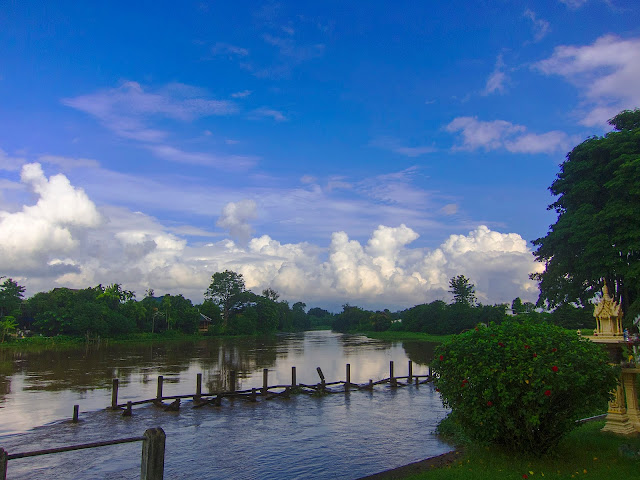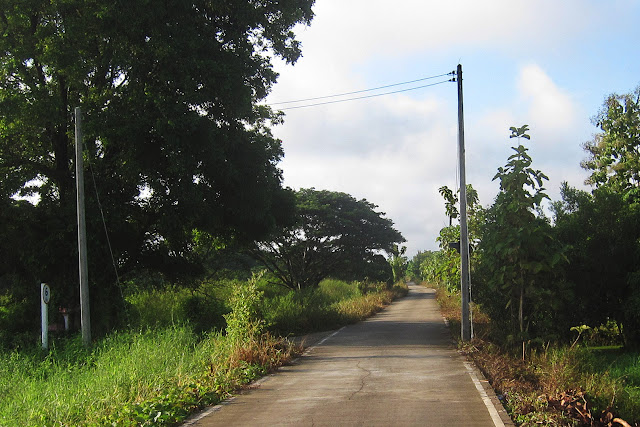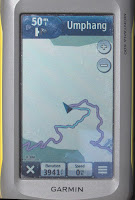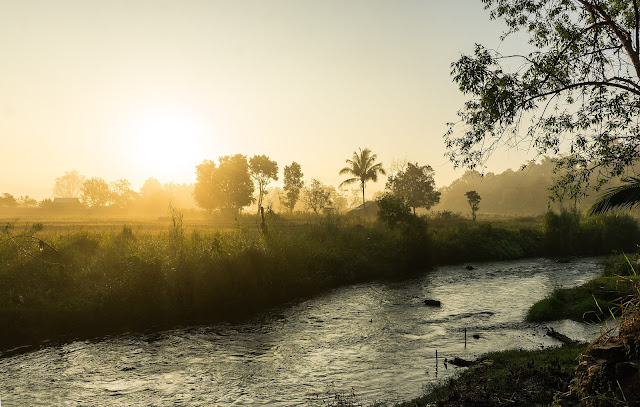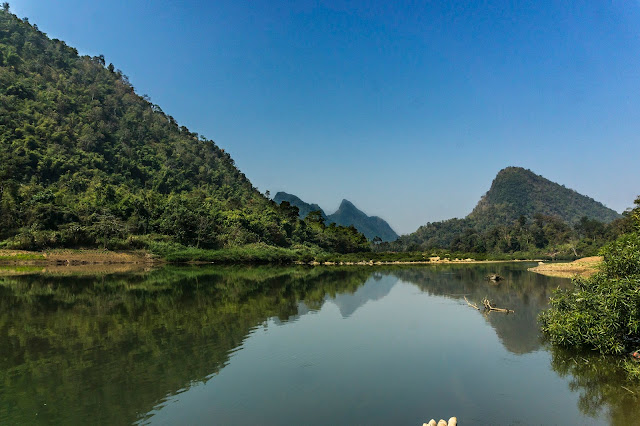When I got back to Thailand in September my plan was to buy an older used car for three or four thousand bucks. I looked and looked but didn't see anything affordable that I liked until this little Honda CR-V showed up at a small used car lot near here. I pulled the dipsticks on both the spotlessly clean engine and the transmission and found the oil and fluid clean and without any burnt smell. I didn't want to buy from a dealer and the asking price was more than I wanted to spend but this car was so clean, immaculate really, that I began the process of rationalization I generally employ before making a buy. The dealer told me "Only one owner and low kilometers!" Sure, I thought. There are no consumer protection laws in Thailand whatsoever and turning speedometers back is, from what I could learn, a fairly common practice. Was the 137,000 km showing on the clock real or someone's idea of reasonable mileage for a 14 year-old car? After a test drive and quite a bit of hemming and hawing I decided to go forward with the purchase and when we went back to do that, Nut requested and got a 5K baht discount. We signed the papers. When I saw the Blue Book (registration) there was, surprise, surprise, only one owner listed and there were dated receipts in the glove box for oil changes that fit nicely into a 137,000 km total mileage scenario. At this point, I had spent about $7,000 USD for what has turned out to be a pretty nice ride.
| Our 2003 Honda CR-V |
In Thailand, people drive on the left side of the road. In addition, everything one used to find on the right side of the steering wheel is now on the left, and vice versa. This makes for some interesting diversions while you drive — signaling a turn with the windshield wipers for example — I'm still doing this with disturbing frequency even after several months. I've been driving cars on the right side of the road for about 60 years and sometimes muscle memory just takes over. Also, learning to judge exactly where those left-side wheels are rolling and where my left fender is, has taken significantly more time than I anticipated. Driving on the left on Thailand's narrow lanes, usually crowded with motorcycles and pedestrians and often lined with markets, makes driving here a royal pain in the ass. Here is an example of a "two lane" rural road in my neighborhood.
The center-line painted by the highway department is hopelessly optimistic, wouldn't you agree? Two vehicles cannot simply move past one another without slowing to a crawl and using the shoulders. To make matters worse, in Thailand a high wall around your property is a sign of status so in residential areas the streets are frequently lined with concrete walls that extend all the way to the corners. This means you must tentatively poke the nose of your vehicle far enough into the intersection to see what's coming before making a turn or proceeding through it. When I first started driving in Thailand, the sight of vehicles sticking their bumpers out into my lane as I approached was disconcerting to say the least. Even after driving here for 8 years, I impulsively grab the brakes on occasion when I see a car poking its nose into my lane.
On a motorcycle, the narrow roads and parked cars cluttering them present no big problem. You simply weave around them. However, in a car, they force one to make frequent stops to allow oncoming vehicles to pass. That means I'm seldom able to get going faster than 15 mph. Thais park right in the road too because there is never room for parking at curbside. Someone stopping to pick up dinner will just leave their car in the street forcing you to cautiously negotiate your way around it. It's a good thing Thai drivers are so patient because an American driver would blow a fuse if faced with such conditions at home. Luckily, Thais seem never to be in a hurry and don't get upset — there's zero road rage here. They wait in nice orderly lines at traffic signals and never ever use the horn. But it's taken some time for me to get used to the slow pace of automobile travel. I seldom go faster than 15 mph when driving in town so if I'm in a hurry I jump on the motorcycle and zip over to wherever I'm going in a fraction of the time.
On with the car story now: We went to Phayao back in October to visit Homer friend DC and his gal, Pai, and we thought it might be interesting to take the car instead of the bike. While the major highways appear wide and smooth from the seat of a motorcycle, in a car one soon realizes they're actually fairly narrow, very curvy, and loaded with little dips and bumps. And there aren't always shoulders so if your left wheel happens to drift off the pavement, well, things could get quite ugly in a hurry. Because of the curves and pavement issues the car lurches from side to side as you drive along at the outrageous speed of 55 mph. It all takes some getting used to. But we had music streaming from my phone via Bluetooth and later in hotter part of the day, air conditioning. One hardly needs a/c in Alaska and I've never owned a car so equipped before. Over here, a/c is a must have.
We arrived at our guest house where we met DC & Pai, and some other fellow expat friends, Bruce & Lois, who split their time between Chiang Rai and Pennsylvania. When I tried to turn into the narrow, raised parking space next to our bungalow, I managed to crumple the left fender and smash the headlight. There were extenuating circumstances: the turn involved driving up a ramp; the corner of the bungalow next to us extended to the driveway at a height of about 3 feet above the ground; my friends were standing in the driveway on the right forcing me to make a wider turn than would be necessary otherwise. Because of my, for lack of a better phrase, right-sidedness bias, I couldn't judge where my left fender was and when the ramp went up, all of a sudden the corner of the bungalow appeared. I drove right into it. The car, virtually unscratched when we bought it, was now seriously crunched and I had done it all by myself! I took one look at the damage and guessed it was gonna cost at least a thousand bucks to fix. Neither of us slept well that night.
 |
| Our once pristine front fender, customized by yours truly |
We took those parts along with the car to a local collision repair shop where we left it for a few days. They charged 6,000 baht total (about $180 USD) for the repair total. The "shop" such as it is, did not inspire confidence. It was just a large roof with a few cars in various states of repair parked here and there beneath it. The collision guy's dad immediately began taking the front end apart while we watched. After three days they called to say the car was ready. The finished job is shown below.
Repairs and parts are much cheaper in Thailand than in the states but I'm always surprised by how much that difference amounts to. Including parts the complete repair cost about $300 USD. I can't imagine how much this repair would have set me back in Alaska.
We've been driving the car quite a bit because I'm teaching Nut how to drive. She's driven motos all her life but never a car. That's an interesting experience and she's been learning fast. I'm recalling and teaching some of the tricks I learned in my high school driver education class so many years ago. We drove the car to Chiang Khong in early December and to Chiang Saen the week before that — Nut did most of the driving. When I checked the fuel mileage after the first week of driving I was disappointed because it only got about 20 mpg. But that was with a full load of passengers and running the aircon full blast. On the trip to Chiang Khong on main highways and in cooler weather, it turned in a respectable 28 mpg or 12 km/liter.
Recapping: Driving in Chiang Mai is a painfully slow and exasperating experience. Repairs and parts, should you need them, are surprisingly cheap.
Several good auto-parts stores in Chiang Mai:
Superhighway near Lanna Hospital: Siang Kong Car Parts (N18.81280° E98.98941°). Used parts.
Mahidol (Airport) Road: Daeng Klon Pratu Parts (N18.76754° E98.98232°) This store is actually part of a giant auto-repair complex that does custom welding, bodywork, etc.
Near Chiang Mai Railway Station: Saha Alai Car Parts (N18.78316° E99.01834)
A huge parts shop selling new and used parts, used diesel and gasoline motors for Japanese cars.
Route 1006 between Superhighway and Second Ring Road: Rungrot Car Parts (N18.78141° E99.03527°). Used parts.



